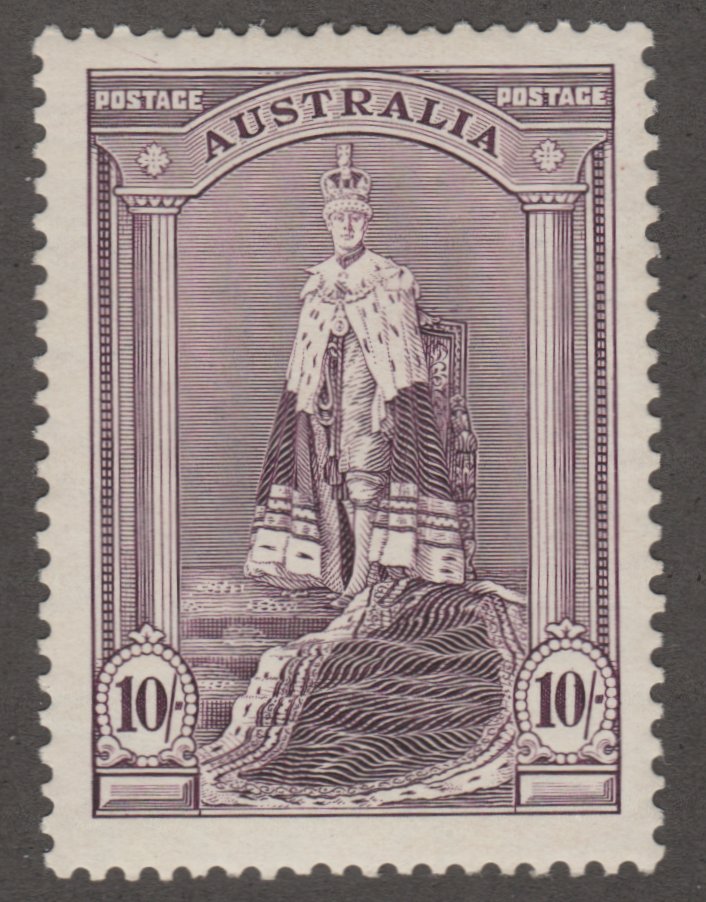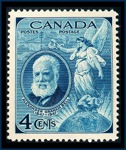
Discussion - Member to Member Sales - Research Center

Discussion - Member to Member Sales - Research Center


05:47:40pm
I also think it's the duty of us "old-timers" to pass on what we know, even if it's only snippets of information that will accumulate and make us all generally better informed. (I celebrate my 50th anniversary of collecting stamps this year!) Ouch!
Accordingly, with your permission (actually, I'm hoping for encouragement!) I'm going to start taking 10 minutes whenever I can to post something of philatelic interest. Maybe it will even spawn some cyber-conversation.
So, for #1 in what will hopefully become a series, I start with:
This is not a color variety!

I lifted this picture from the rotating pictures in our header. I presume someone who submitted it thought that this was an interesting color variation. Sorry, the stamp on the left is a "damaged" stamp -- damaged by water.
The stamps of late Queen Victoria to Edward were printed with "fugitive" inks -- that means they run in water. The stamp on the right is a very nice used copy, with basically original color.
See the following - what Stanley Gibbons Specialized has to say about them. Note particularly the reference to the green inks for the "head" plate (the "duty plate" printed the outside, and you will note it is not water sensitive.)

I'd be happy to hear whether you think this sort of thing worthwhile, or if I'll be accused of "pontificating".


Login to Like
this post
I do indeed think it's worthwhile! Please -- everyone! -- continue!
I didn't know that that particular issue was printed with fugitive ink. I am familiar with fugitive inks, however. Several years ago I was washing a bunch of used G.B. stamps and discovered another KGV issue that was printed with fugitive ink, but I only learned about when I pulled some perfectly blank "stamps" from their first bath.
Bob
P.S. Yesterday my wife and I went to see "The King's Speech". Excellent film, which portrayed KGV as a rather cruel tyrant, at least in his relationship with George (who of course would become King George VI).

Login to Like
this post

09:31:57pm
Did they actually call him "George" in the movie while his father was alive?
His name was actually "Albert Frederick Arthur George" and I understood he was "Prince Albert, Duke of York" until he ascended the throne and took his fourth name as "King George VI", rather than the first "King Albert", probably in deference to his great-grandmother Victoria's known feelings toward her "Albert".

Roy

Login to Like
this post
Roy,
I think this is great and very worthwhile. Please keep them coming.
Alyn

Login to Like
this post
I love learning about stamps; and who knows but that i'll need to refer to fugitive inks one day and remember that Roy wrote about it and search the archives that go back to our earliest days when Roy was administering the site. Have at it.
Now, the next question, was the fugitive ink uninttentional, a factor of expense, or an attempt to discourage re-use?
David

Login to Like
this post

12:36:58pm
quote:Now, the next question, was the fugitive ink unintentional, a factor of expense, or an attempt to discourage re-use?
The latter -- to discourage reuse. You will note that the water soluble inks were particularly used on the bi-coloured high values. (The really high values -- 5/- and up -- were typically nailed so hard with cancellations that it wasn't an issue!)
Roy

Login to Like
this post
Excellent tidbits, Roy. I'm looking forward to whatever you have to offer. Could I encourage you to consider commenting on the U.S.Classics (SCN#1-600) after you've completed your comments on the Great Britain issues?
Dan C.

Login to Like
this post
Great "snippet"
Thanks

Login to Like
this post
Hey "snippet" ... Thanks for the information. I thought they were the CARMINE (138d) vs the SCARLETT (138e) ..... see, what do I know?

Perry

Login to Like
this post
Roy's original example in this old thread is missing, but I found this pair mounted side by side in an old album over the weekend. The stamp's color ink was clear more fugitive than either the black print ink or the cancellation ink.
Cape Verde Scott #49 violet.



Login to Like
this post
BuckaCover.com - 80,000 covers priced 60c to $1.50 - Easy browsing 500 categories
03 Mar 2011
05:47:40pm
One of the things that's good about a stamp club is that everybody has the opportunity to learn new things by eavesdropping on conversations (welcome eavesdropping of course!). And since day one, I have always thought of a "real-world" stamp club as a model for our "cyber-stampclub" wherever it's possible.
I also think it's the duty of us "old-timers" to pass on what we know, even if it's only snippets of information that will accumulate and make us all generally better informed. (I celebrate my 50th anniversary of collecting stamps this year!) Ouch!
Accordingly, with your permission (actually, I'm hoping for encouragement!) I'm going to start taking 10 minutes whenever I can to post something of philatelic interest. Maybe it will even spawn some cyber-conversation.
So, for #1 in what will hopefully become a series, I start with:
This is not a color variety! 
I lifted this picture from the rotating pictures in our header. I presume someone who submitted it thought that this was an interesting color variation. Sorry, the stamp on the left is a "damaged" stamp -- damaged by water.
The stamps of late Queen Victoria to Edward were printed with "fugitive" inks -- that means they run in water. The stamp on the right is a very nice used copy, with basically original color.
See the following - what Stanley Gibbons Specialized has to say about them. Note particularly the reference to the green inks for the "head" plate (the "duty plate" printed the outside, and you will note it is not water sensitive.)

I'd be happy to hear whether you think this sort of thing worthwhile, or if I'll be accused of "pontificating". 

Login to Like
this post

re: Not a color variety: Philatelic Ramblings
I do indeed think it's worthwhile! Please -- everyone! -- continue!
I didn't know that that particular issue was printed with fugitive ink. I am familiar with fugitive inks, however. Several years ago I was washing a bunch of used G.B. stamps and discovered another KGV issue that was printed with fugitive ink, but I only learned about when I pulled some perfectly blank "stamps" from their first bath.
Bob
P.S. Yesterday my wife and I went to see "The King's Speech". Excellent film, which portrayed KGV as a rather cruel tyrant, at least in his relationship with George (who of course would become King George VI).

Login to Like
this post
BuckaCover.com - 80,000 covers priced 60c to $1.50 - Easy browsing 500 categories
03 Mar 2011
09:31:57pm
re: Not a color variety: Philatelic Ramblings
Did they actually call him "George" in the movie while his father was alive?
His name was actually "Albert Frederick Arthur George" and I understood he was "Prince Albert, Duke of York" until he ascended the throne and took his fourth name as "King George VI", rather than the first "King Albert", probably in deference to his great-grandmother Victoria's known feelings toward her "Albert".

Roy

Login to Like
this post

re: Not a color variety: Philatelic Ramblings
Roy,
I think this is great and very worthwhile. Please keep them coming.
Alyn

Login to Like
this post
Auctions
re: Not a color variety: Philatelic Ramblings
I love learning about stamps; and who knows but that i'll need to refer to fugitive inks one day and remember that Roy wrote about it and search the archives that go back to our earliest days when Roy was administering the site. Have at it.
Now, the next question, was the fugitive ink uninttentional, a factor of expense, or an attempt to discourage re-use?
David

Login to Like
this post
BuckaCover.com - 80,000 covers priced 60c to $1.50 - Easy browsing 500 categories
04 Mar 2011
12:36:58pm
re: Not a color variety: Philatelic Ramblings
quote:Now, the next question, was the fugitive ink unintentional, a factor of expense, or an attempt to discourage re-use?
The latter -- to discourage reuse. You will note that the water soluble inks were particularly used on the bi-coloured high values. (The really high values -- 5/- and up -- were typically nailed so hard with cancellations that it wasn't an issue!)
Roy

Login to Like
this post

re: Not a color variety: Philatelic Ramblings
Excellent tidbits, Roy. I'm looking forward to whatever you have to offer. Could I encourage you to consider commenting on the U.S.Classics (SCN#1-600) after you've completed your comments on the Great Britain issues?
Dan C.

Login to Like
this post
09:42:19am
re: Not a color variety: Philatelic Ramblings
Great "snippet"
Thanks

Login to Like
this post

re: Not a color variety: Philatelic Ramblings
Hey "snippet" ... Thanks for the information. I thought they were the CARMINE (138d) vs the SCARLETT (138e) ..... see, what do I know?

Perry

Login to Like
this post

re: Not a color variety: Philatelic Ramblings
Roy's original example in this old thread is missing, but I found this pair mounted side by side in an old album over the weekend. The stamp's color ink was clear more fugitive than either the black print ink or the cancellation ink.
Cape Verde Scott #49 violet.



Login to Like
this post

